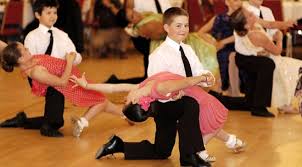The History of Ballroom Dancing goes back to the medieval folk dancing. Dancing in pairs was first recorded in Italy at the beginning of the 15th century.
 In the 16th century in France arose ballet from the court dance. In the 17th and 18th centuries came from the court of King Louis much incentive for expressing (dance) art in France. There were clothes fashions with great dresses and corsets for the ladies. The men wore the forerunners of our "smart suits" and walked on high heels. The dances were performed stately (and rather stiff) because they could not move properly move in this.
In the 16th century in France arose ballet from the court dance. In the 17th and 18th centuries came from the court of King Louis much incentive for expressing (dance) art in France. There were clothes fashions with great dresses and corsets for the ladies. The men wore the forerunners of our "smart suits" and walked on high heels. The dances were performed stately (and rather stiff) because they could not move properly move in this.
Especially the last 100 years, everything has become more and more swinging, and Ballroom dancing has come to its present form. Weather variations, too, have come, as with the emergence of Rock'n Roll. Yet, it is typical that the Latin dances are looser and more frivolous than the European dance. For example there are two forms of the Tango, Argentine and Ballroom version.
North America delivered early 20th century all the elements of the British -style ballroom, tango was just this one major exception.
In 1909, the first world championships ballroom dancing were held in Paris. Today various organizations have ballroom dancing competitions, virtually all over the world often each with their own rules. It is now possible in all countries to have dance seasons with multiple games per month. Just as in football, there are different categories and regions.
Between 1920 and 1930 a group of British professional dancers designed four existing dances by comparing all existing dances and impose strict rules in every single dance: waltz, slowfox (trot), quickstep, tango were so designed.
They could be danced to the popular music of the time by the general public.
Together with the Viennese waltz, a particular variant from Germany, were these dances called ballroom dancing.
Standard Dances: those (ballroom- and Latin-) dances are standardized. The basic steps and basic figures are globally uniformly done the same way, allowing all dancers to dance together (and there are competitions and comparisons possible).
Standardization
The technique of the standard dances is recorded by Alex Moore. This Englishman has all the standard dances decomposed and developed a format that is still used as study by the international dance world. In 1948 he published The Ballroom Technique, the classic reference for these dances.
To my taste, there 's too many rules, regulations, rules and competitions in ballroom. That makes the dance dead. Dance has to live. If you only may do what is prescribed, or should only try to do it a bit better or more elegant than another (couple), then there is no room for evolution and innovation. Pity. Dancing do not belong in a straitjacket. The overly stately style does not fit in this time. You notice it at parties and events: Latin dominates, it must swing...
